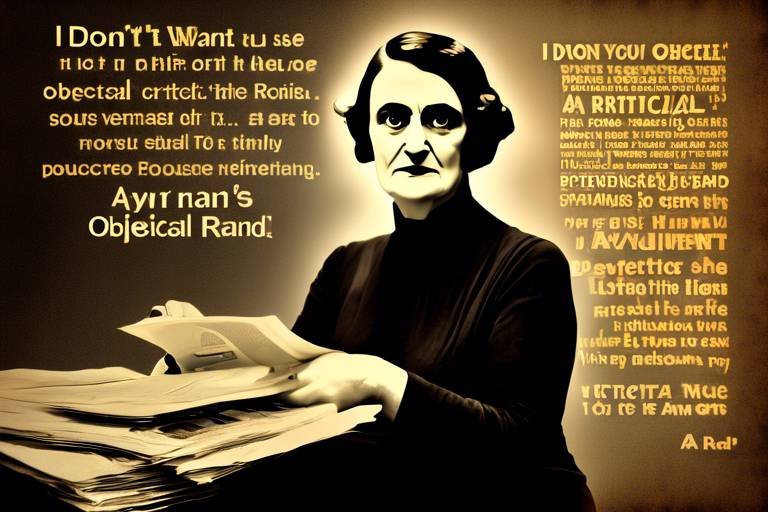Are Logical Inconsistencies Ruining Your Reasoning?
Have you ever found yourself in a heated debate, only to realize that the arguments being thrown around are as tangled as a ball of yarn? Logical inconsistencies can be the sneaky culprits that turn rational discussions into chaotic exchanges. They undermine effective reasoning, leading us down a rabbit hole of flawed conclusions that can distort our decision-making and critical thinking.
Imagine you're trying to solve a puzzle, but some of the pieces just don't fit together. That's what logical inconsistencies do to our thought processes—they create confusion and make it nearly impossible to see the bigger picture. When statements contradict one another, it becomes challenging to discern what’s true and what’s not. This is why understanding these inconsistencies is crucial for anyone looking to sharpen their reasoning skills and engage in meaningful conversations.
In this article, we’ll dive into the murky waters of logical inconsistencies, exploring various types and their impact on how we think and communicate. From common logical fallacies to the role of cognitive biases, we’ll uncover how these elements disrupt coherent reasoning and can lead to misunderstandings. So, buckle up and get ready to enhance your critical thinking skills!
Logical inconsistencies arise when two or more statements contradict each other. Think of it like trying to bake a cake with a recipe that calls for both sugar and salt as the main ingredient—something just doesn’t add up! These inconsistencies are significant in rational thought processes because they can lead to erroneous conclusions and misguided beliefs. When we encounter contradictions, our brains struggle to reconcile the conflicting information, often resulting in confusion and misinterpretation.
Take a moment to reflect on your own reasoning. Have you ever found yourself believing two opposing ideas at once? It’s more common than you might think! This phenomenon can lead to cognitive dissonance, where we hold conflicting beliefs and feel discomfort as a result. Understanding logical inconsistencies is the first step in overcoming them, allowing us to engage in more productive and rational discussions.
Now that we’ve laid the groundwork, let’s explore some prevalent logical fallacies that can derail our reasoning. These fallacies often pop up in everyday conversations and debates, making it essential to recognize them. Here are a few key players in the world of logical inconsistencies:
- Ad Hominem: Attacking the person instead of their argument.
- Straw Man: Misrepresenting an opponent's argument to make it easier to attack.
- Slippery Slope: Arguing that one small step will inevitably lead to a chain of related events.
Each of these fallacies has its own unique way of disrupting coherent reasoning and can mislead discussions. In the sections that follow, we’ll take a closer look at the ad hominem and straw man fallacies, examining their impacts on debates and discussions.
The ad hominem fallacy is a classic example of a logical inconsistency. Instead of addressing the argument at hand, it attacks the character of the person making the argument. This tactic diverts attention from the actual issue and can lead to a breakdown in communication. Imagine a debate where one participant starts criticizing the other’s appearance or personal life instead of discussing the topic. It’s not only distracting, but it also undermines the integrity of the discussion.
Consider a scenario where two friends are debating the merits of a political policy. Instead of discussing the policy itself, one friend says, "You can’t trust him; he’s been divorced twice!" This statement doesn’t address the policy and instead attacks the person’s character. Such examples highlight how ad hominem attacks can derail constructive conversations and hinder logical reasoning.
The consequences of using ad hominem fallacies can be significant. They can lead to:
- A breakdown in communication
- A lack of trust among participants
- An escalation of conflict
When discussions devolve into personal attacks, it becomes nearly impossible to reach a mutual understanding. Recognizing and avoiding this fallacy is crucial for fostering healthy dialogue.
The straw man fallacy is another common logical inconsistency that misrepresents an opponent's argument. Instead of engaging with the actual argument, it creates a distorted version that is easier to attack. Picture a debate where one person says, "We should have stricter regulations on pollution," and the other replies, "My opponent wants to shut down all factories!" This misrepresentation can lead to confusion and mislead audiences, making it essential to address arguments accurately.
Cognitive biases play a significant role in logical inconsistencies, affecting how individuals process information. These biases can lead us to make irrational decisions or cling to flawed reasoning. Some common cognitive biases include:
- Confirmation Bias: Favoring information that confirms our pre-existing beliefs.
- Anchoring Bias: Relying too heavily on the first piece of information encountered.
Understanding these biases is crucial for improving our reasoning skills. By recognizing how they influence our thoughts, we can work towards more rational and informed decision-making.
Confirmation bias can severely skew our reasoning. When we favor information that supports our beliefs, we often overlook contradictory evidence. This bias can lead to a distorted view of reality, making it challenging to engage in constructive discussions. For instance, if someone believes that a particular diet is the best, they might only seek out articles that support that view while dismissing opposing research.
Anchoring bias occurs when individuals place too much emphasis on the first piece of information they encounter. This bias can significantly affect decision-making and reasoning processes. For example, if someone hears that a product usually costs $100 but is on sale for $70, they may perceive it as a great deal, even if the actual value is much lower. Understanding this bias can help us make more informed choices.
Q: What are logical inconsistencies?
A: Logical inconsistencies occur when statements contradict each other, leading to confusion and flawed reasoning.
Q: How do logical fallacies affect discussions?
A: Logical fallacies disrupt coherent reasoning and can mislead discussions, often resulting in misunderstandings.
Q: What is confirmation bias?
A: Confirmation bias is the tendency to favor information that supports our existing beliefs while ignoring contradictory evidence.
Q: How can I improve my reasoning skills?
A: By recognizing logical fallacies and cognitive biases, you can enhance your critical thinking and engage in more meaningful conversations.

Understanding Logical Inconsistencies
This article explores how logical inconsistencies can undermine effective reasoning, leading to flawed conclusions. We will examine various types of inconsistencies and their impact on decision-making and critical thinking.
Logical inconsistencies are like the pesky weeds in a beautiful garden of thoughts; they can choke the life out of clear reasoning and lead to chaotic conclusions. At their core, these inconsistencies arise when statements or beliefs contradict each other, creating a tangled web of confusion. Imagine trying to navigate through a maze where the paths keep changing; that’s what logical inconsistencies do to our thought processes. They not only muddle our understanding but also hinder our ability to make sound decisions.
To grasp the significance of logical inconsistencies, consider this: they can distort our perception of reality and influence our actions in profound ways. For instance, if a person believes that all cats are friendly but then encounters an unfriendly cat, they might dismiss the experience rather than reevaluate their belief. This refusal to reconcile conflicting information exemplifies how logical inconsistencies can lead to flawed reasoning.
Furthermore, logical inconsistencies can manifest in various forms, such as:
- Contradictory Statements: When two statements cannot both be true at the same time, it creates a logical inconsistency. For example, saying "I love dogs" and "I hate all animals" cannot coexist without contradiction.
- Self-Refuting Claims: A statement that contradicts itself is inherently inconsistent. For instance, claiming "I am a liar" creates a paradox.
- Inconsistent Beliefs: Holding beliefs that conflict with each other can lead to confusion. For example, believing in free will while also believing in predestination creates a logical inconsistency.
Recognizing these inconsistencies is crucial for anyone seeking to engage in rational discourse. They can derail conversations, mislead arguments, and ultimately lead to poor decision-making. When we fail to address logical inconsistencies, we risk falling into a trap of flawed reasoning, where our conclusions are based on shaky ground.
In summary, understanding logical inconsistencies is essential for developing critical thinking skills. By identifying and addressing these inconsistencies, we can enhance our reasoning abilities and engage in more productive discussions. The next time you find yourself tangled in a web of contradictions, take a step back and reassess your thoughts. Are your beliefs aligned? Are there inconsistencies that need addressing? By doing so, you’ll pave the way for clearer, more effective reasoning.
This section will delve into prevalent logical fallacies, such as ad hominem and straw man arguments, explaining how they disrupt coherent reasoning and can mislead discussions.
The ad hominem fallacy attacks the person rather than their argument, diverting attention from the actual issue. This section will illustrate its impact on debates and discussions.
Real-world examples of ad hominem attacks will be presented here, showcasing how they can derail constructive conversations and hinder logical reasoning.
The consequences of using ad hominem fallacies can include a breakdown in communication and a lack of trust among participants. This section will explore these effects further.
The straw man fallacy misrepresents an opponent's argument to make it easier to attack. This section will discuss how this tactic can distort reasoning and mislead audiences.
Cognitive biases significantly contribute to logical inconsistencies, affecting how individuals process information. This section will explore various biases and their implications for reasoning.
Confirmation bias leads individuals to favor information that confirms their pre-existing beliefs, often overlooking contradictory evidence. This section will examine how this bias can skew reasoning.
Anchoring bias occurs when individuals rely too heavily on the first piece of information encountered. This section will discuss its effects on decision-making and reasoning processes.
Q1: What are logical inconsistencies?
A: Logical inconsistencies are contradictions in statements or beliefs that can confuse reasoning and lead to flawed conclusions.
Q2: How do logical fallacies affect discussions?
A: Logical fallacies disrupt coherent reasoning, mislead arguments, and often derail constructive conversations.
Q3: Can cognitive biases contribute to logical inconsistencies?
A: Yes, cognitive biases can skew our reasoning and lead to inconsistencies in how we process information.

Common Types of Logical Fallacies
When it comes to reasoning, logical fallacies are like pesky weeds in a garden; they can choke the life out of clear thinking and lead us down a path of confusion. These fallacies are errors in reasoning that can distort arguments and mislead discussions, making it crucial to identify and understand them. By recognizing these common types of logical fallacies, we can sharpen our critical thinking skills and enhance our decision-making processes.
One of the most notorious fallacies is the ad hominem attack. Instead of addressing the argument itself, this fallacy diverts attention by attacking the person making the argument. Imagine you're in a debate about climate change, and instead of discussing the evidence, someone says, "You can't trust her; she's not even a scientist!" This tactic not only sidesteps the actual issue but can also create a toxic atmosphere where genuine discourse is stifled.
Another prevalent fallacy is the straw man argument. This occurs when someone misrepresents their opponent's position to make it easier to attack. For instance, if one person advocates for more humane treatment of animals and the other responds, "So you want to ban all pets?" they're creating a straw man. This tactic not only distorts the original argument but can also mislead audiences who may not be familiar with the nuances of the discussion.
Logical fallacies can be categorized into several types, and understanding these categories can help us recognize them in everyday conversations. Here are a few common types:
- Ad Hominem: Attacking the individual instead of the argument.
- Straw Man: Misrepresenting an argument to make it easier to attack.
- Appeal to Authority: Relying on the opinion of an authority figure instead of presenting evidence.
- False Dichotomy: Presenting only two options when more exist.
- Slippery Slope: Arguing that a small first step will inevitably lead to a chain of related events.
By familiarizing ourselves with these fallacies, we can better navigate discussions and avoid falling prey to flawed reasoning. It’s essential to remember that everyone can fall into the trap of logical fallacies, especially when emotions run high or when we are deeply invested in a particular viewpoint. Therefore, maintaining a level head and striving for clarity can greatly enhance our ability to communicate effectively and reason soundly.
In conclusion, recognizing logical fallacies is like having a map in a dense forest. It helps us find our way through the convoluted paths of arguments and discussions, ensuring that we don't get lost in the weeds of misinformation and flawed reasoning. By sharpening our awareness of these common fallacies, we can engage in more meaningful conversations and make better-informed decisions.

Ad Hominem Fallacy
The is a logical misstep that many people encounter in debates and discussions. Instead of addressing the argument at hand, this fallacy attacks the character or personal traits of the individual presenting the argument. Imagine you're in a heated discussion about climate change, and instead of tackling the facts, someone says, "Well, you drive a gas-guzzling car, so your opinion doesn't matter." This is a classic ad hominem attack—it's diverting attention from the actual issue and focusing on the person instead.
Ad hominem fallacies can take various forms, and they often manifest in everyday conversations, social media exchanges, and even in political debates. They can be subtle or overt, but the underlying effect is the same: they derail constructive dialogue and hinder logical reasoning. By targeting the individual rather than their ideas, these attacks can create an environment where rational discourse is nearly impossible. Instead of engaging with the argument, participants may find themselves caught up in personal attacks, leading to a breakdown in communication.
Let’s break down the impact of ad hominem attacks on discussions:
- Distracts from the Issue: When personal attacks are made, the focus shifts away from the argument, making it difficult to reach a resolution.
- Creates Division: Ad hominem fallacies can foster hostility and division among participants, making it challenging to find common ground.
- Undermines Trust: When individuals resort to personal attacks, it can damage trust and respect, leading to a toxic environment for dialogue.
In essence, the ad hominem fallacy is more than just a logical error; it’s a barrier to effective communication. It encourages a culture of defensiveness rather than openness, where individuals feel they must protect themselves rather than engage critically with differing viewpoints. To combat this fallacy, it's essential to foster an atmosphere where ideas can be discussed without fear of personal attacks. By focusing on the argument rather than the individual, we can promote healthier, more productive discussions.
In the next section, we will explore real-world examples of ad hominem attacks to illustrate their prevalence and impact on logical reasoning.

Examples of Ad Hominem
Ad hominem attacks are everywhere, and they can be quite sneaky. Imagine you're in a heated debate about climate change, and instead of addressing the scientific evidence, one participant suddenly says, “Well, you’re not even a scientist, so what do you know?” This statement doesn't tackle the argument itself; instead, it aims to undermine the credibility of the person presenting the argument. It's like trying to win a race by tripping your opponent instead of running faster. This tactic not only derails the conversation but also distracts from the real issues at hand.
Another classic example can be found in political debates. Picture a candidate who, instead of responding to criticism regarding their policy proposals, retorts with, “You can’t trust my opponent; they’ve been divorced three times!” Here, the focus shifts from the policies themselves to the personal life of the opponent, which is irrelevant to the topic being discussed. This is akin to judging a chef's skills based on their choice of outfit rather than their culinary creations.
To further illustrate the prevalence of ad hominem attacks, consider the following scenarios:
- Online Discussions: In the world of social media, it’s not uncommon for users to dismiss others' opinions by attacking their character or personal traits instead of engaging with their arguments. For instance, someone might say, “You’re just a teenager; what do you know about economics?”
- Workplace Conflicts: During team meetings, an employee might say, “How can we trust your judgment on this project when you’ve failed to meet deadlines in the past?” This shifts the focus from the current proposal to past mistakes, which may not even be relevant.
- Academic Settings: In a classroom debate, a student might counter a peer's argument by saying, “You only think that because you’re from a wealthy background.” This not only dismisses the argument but also introduces an irrelevant personal detail.
These examples highlight how ad hominem attacks can create an environment where genuine dialogue is stifled. Instead of fostering understanding, these tactics lead to misunderstandings and resentment. Ultimately, when we resort to personal attacks, we miss out on the opportunity to engage in productive discussions that could lead to meaningful solutions. It’s essential to recognize these patterns and strive for a more respectful and logical approach in our conversations.
In conclusion, while it may feel satisfying to attack the person rather than their argument, it rarely leads to constructive outcomes. By focusing on the issues at hand and avoiding ad hominem tactics, we can create a space where logical reasoning thrives, and meaningful discussions can take place.
Q: What is an ad hominem fallacy?
A: An ad hominem fallacy occurs when someone attacks the character or traits of a person making an argument rather than addressing the argument itself. It's a diversionary tactic that undermines logical reasoning.
Q: Why are ad hominem attacks harmful?
A: These attacks can derail discussions, create misunderstandings, and foster an environment of distrust. They distract from the actual issues and prevent constructive dialogue.
Q: How can I avoid using ad hominem attacks in my discussions?
A: Focus on the arguments being presented rather than the person making them. Practice active listening and respond to the content of the argument, not the individual’s character or background.

Consequences of Ad Hominem
The use of ad hominem fallacies can have significant consequences that ripple through discussions and debates, affecting not just the immediate conversation but also the broader context of communication. When individuals resort to attacking the person rather than addressing the argument, several detrimental effects can emerge. First and foremost, it creates a toxic environment where rational discourse is stifled. Participants may feel defensive or insulted, leading to a breakdown in effective communication. Instead of engaging in a constructive dialogue, the focus shifts to personal attacks, which can derail the entire conversation.
Moreover, the reliance on ad hominem tactics can lead to a lack of trust among participants. When someone feels that their character is under attack, they may become less willing to share their thoughts openly. This can foster an atmosphere of suspicion where individuals question each other's motives rather than focusing on the issues at hand. In such cases, the quality of discourse diminishes, as people become more concerned with defending themselves than with exploring ideas and solutions.
Additionally, the consequences extend beyond individual interactions. In public discourse, such as political debates or media discussions, the prevalence of ad hominem attacks can shape public perception and influence opinions. When audiences see leaders or public figures engaging in personal attacks, they may begin to view discussions as divisive rather than collaborative. This can lead to a polarized society where people are more entrenched in their views, making it increasingly difficult to find common ground.
In summary, the consequences of ad hominem fallacies are profound. They not only hinder effective communication but also erode trust and foster divisiveness within society. To promote healthier discussions, it's crucial to recognize and address these fallacies, encouraging a focus on the arguments themselves rather than the individuals presenting them. By doing so, we can create a more respectful and productive dialogue that benefits everyone involved.
- What is an ad hominem fallacy?
An ad hominem fallacy occurs when someone attacks the character or motives of a person instead of addressing the argument they are making. - Why is ad hominem harmful?
It distracts from the actual issue being discussed and can lead to a breakdown in communication and trust among participants. - How can I avoid using ad hominem in discussions?
Focus on the argument at hand and refrain from making personal attacks. Stay calm and address the points being made rather than the person making them.

Straw Man Fallacy
The is a common tactic in debates and discussions, where one party distorts or oversimplifies the argument of their opponent to make it easier to attack. Imagine you're in a conversation about the benefits of renewable energy, and your friend responds by claiming, "So you think we should just stop using all fossil fuels immediately and live in the dark?" This is a classic example of a straw man argument. Instead of addressing the nuances of your original point, your friend has created a simplified version that is much easier to knock down.
This fallacy is not just a minor annoyance; it can have significant implications for effective reasoning and communication. By misrepresenting the opponent's position, the person using the straw man fallacy shifts the focus away from the real issues at hand. This can lead to confusion, frustration, and ultimately, a breakdown in constructive dialogue. It’s like trying to hit a moving target that doesn’t even exist; you’re expending energy on something that isn’t the real issue.
Moreover, the straw man fallacy can mislead audiences who may not be aware of the original argument. When someone hears a distorted version of a position, they might develop a biased understanding of the topic. This can perpetuate misunderstandings and foster an environment where logical reasoning is overshadowed by emotional responses. In essence, it’s like trying to build a house on a shaky foundation; the structure of the argument becomes unstable and unreliable.
To illustrate the impact of the straw man fallacy, consider the following table that highlights its characteristics and effects:
| Characteristic | Effect |
|---|---|
| Misrepresentation of Argument | Creates confusion and misleads the audience |
| Oversimplification | Ignores the complexity of the issue |
| Shift in Focus | Diverts attention from the real argument |
| Emotional Manipulation | Can provoke strong emotional reactions |
In conclusion, recognizing and addressing the straw man fallacy is crucial for anyone engaged in critical thinking or debate. By ensuring that arguments are represented accurately and fairly, we can foster a more productive dialogue that leads to better understanding and decision-making. Remember, it’s not just about winning the argument; it’s about seeking truth and clarity in our discussions.
- What is a straw man fallacy?
A straw man fallacy occurs when someone misrepresents an opponent's argument to make it easier to attack. - Why is the straw man fallacy problematic?
It distracts from the real issues and can lead to misunderstanding and miscommunication. - How can I avoid using straw man arguments?
Always strive to represent your opponent's views accurately and engage with their actual points. - Can straw man fallacies be used intentionally?
Yes, some individuals may use them deliberately to manipulate the discussion in their favor.

The Role of Cognitive Biases
Cognitive biases are like the sneaky gremlins of our thinking processes. They creep in, often without us even realizing it, and can lead us to make decisions that are less than rational. These biases can distort our perception of reality, causing us to interpret information in a way that aligns with our pre-existing beliefs rather than the facts at hand. Imagine trying to navigate through a foggy landscape; that’s what reasoning can feel like when cognitive biases cloud our judgment. In this section, we’ll explore some of the most common cognitive biases and how they can wreak havoc on our logical reasoning.
One of the most prevalent cognitive biases is known as confirmation bias. This is when we selectively gather or interpret information in a way that confirms what we already believe. Picture this: you’re a die-hard fan of a particular sports team. You only pay attention to news articles that praise your team and ignore those that critique them. This bias not only narrows your perspective but can also lead to flawed reasoning when discussing your team’s performance with others. The danger here is that confirmation bias can create an echo chamber, where our beliefs are reinforced without the challenge of opposing viewpoints.
Another cognitive bias that plays a significant role in our reasoning is anchoring bias. This occurs when we give too much weight to the first piece of information we encounter, which can skew our decision-making. For instance, if you’re shopping for a car and the first one you see is priced at $30,000, you might anchor your perception of value around that figure. Even if you later see a better car for $25,000, you may still think the latter is a good deal because of that initial anchor. This bias can lead to poor choices, as it can limit our ability to evaluate options fairly.
To illustrate how cognitive biases can intertwine with logical inconsistencies, consider a hypothetical scenario involving a debate on climate change. An individual might be so anchored to the idea that climate change is a hoax that they only seek out information that supports this view (confirmation bias). They might dismiss scientific studies or expert opinions that contradict their belief, leading to a flawed understanding of the issue. This combination of biases not only undermines their reasoning but also hinders constructive dialogue on a critical topic.
Understanding these cognitive biases is crucial for improving our reasoning skills. By recognizing how they influence our thought processes, we can actively work to mitigate their effects. This might involve seeking out diverse perspectives, challenging our own beliefs, or simply being more aware of the information we consume. After all, the goal is to foster a more rational and informed approach to decision-making, rather than allowing biases to steer us off course.
- What are cognitive biases? Cognitive biases are systematic patterns of deviation from norm or rationality in judgment, leading to illogical inferences or decisions.
- How do cognitive biases affect decision-making? They can distort our perception of information, leading us to make choices based on flawed reasoning rather than objective analysis.
- Can cognitive biases be overcome? While it may be challenging, being aware of these biases and actively seeking diverse viewpoints can help mitigate their impact.

Confirmation Bias
Confirmation bias is one of those sneaky little tricks our brains play on us. Imagine you’re trying to decide whether to buy a new smartphone. You’ve heard mixed reviews, but you only seek out articles and videos that praise the model you want. This is confirmation bias at work—it’s like wearing blinders that only let in information that aligns with your desires. Instead of weighing all the available evidence, you cherry-pick the facts that support your pre-existing belief, while ignoring anything that contradicts it. This can lead to poor decision-making, as you might end up with a product that doesn’t meet your needs simply because you didn’t consider the full picture.
But why does this happen? Well, our brains are wired to seek consistency. When we encounter information that challenges our beliefs, it creates cognitive dissonance—a mental discomfort that we naturally want to avoid. So, instead of confronting that discomfort, we choose the easier path: we filter out the conflicting information. This bias doesn’t just affect our purchasing decisions; it can permeate all aspects of our lives, from politics to personal relationships.
Consider the impact of confirmation bias in political discussions. When individuals only engage with news sources that align with their political views, they become trapped in an echo chamber. This not only reinforces their beliefs but also alienates them from opposing viewpoints. The result? A society that struggles to communicate effectively and understand differing perspectives. To illustrate this further, let’s take a look at a simple table that outlines how confirmation bias manifests in different areas:
| Area of Impact | Example of Confirmation Bias |
|---|---|
| Politics | Only following news outlets that support one's political party. |
| Health | Seeking out studies that support a preferred diet while ignoring contrary evidence. |
| Finance | Investors focusing on positive reports about their stocks and dismissing negative forecasts. |
As you can see, confirmation bias can manifest in various contexts, leading to skewed perceptions and potentially flawed conclusions. So, how can we combat this bias? The first step is awareness. Acknowledge that you have biases, and actively seek out information that challenges your views. Engage in discussions with people who hold different opinions, and be open to changing your mind based on new evidence. By doing so, you’ll not only enhance your reasoning abilities but also foster a more inclusive and understanding environment.
In conclusion, confirmation bias is a powerful force that can cloud our judgment and distort our reasoning. By recognizing its effects and striving for a balanced perspective, we can make more informed decisions and engage in healthier dialogues. So the next time you find yourself leaning towards information that feels comfortable, take a moment to question whether you’re truly being objective. Are you seeking the truth, or just the validation of your beliefs?
- What is confirmation bias? Confirmation bias is the tendency to search for, interpret, and remember information in a way that confirms one’s pre-existing beliefs.
- How does confirmation bias affect decision-making? It can lead to poor choices as individuals may ignore evidence that contradicts their beliefs, resulting in skewed perceptions and flawed conclusions.
- Can confirmation bias be overcome? Yes, by actively seeking out diverse perspectives and being open to new information, individuals can mitigate the effects of confirmation bias.

Anchoring Bias
is a fascinating psychological phenomenon that affects our decision-making processes in ways we often don’t realize. Imagine you're shopping for a car. The first price you see, say $30,000, sets a mental "anchor" in your mind. Even if you later see the same car for $25,000, you might still think, "That's a good deal!" because your brain is still clinging to that initial price. This tendency to rely too heavily on the first piece of information we encounter can lead to skewed judgments and decisions.
The implications of anchoring bias are far-reaching. In negotiations, for instance, the initial offer can set the tone for the entire discussion. If one party starts with a high figure, the other party may adjust their expectations based on that anchor, even if the offer is unreasonable. This can lead to outcomes that are less favorable for both sides. The truth is, anchors can influence our perceptions of value, risk, and even our emotional responses to situations.
To further illustrate this concept, consider a study where participants were asked to estimate the percentage of African nations in the United Nations. Before answering, they were shown a random number, either 10 or 65. Those who saw the number 10 tended to guess lower, around 25%, while those who saw 65 guessed significantly higher, around 45%. This example highlights how arbitrary information can shape our understanding and judgments, often without us even being aware of it.
So, how can we combat the effects of anchoring bias in our everyday lives? Here are a few strategies:
- Awareness: Simply being aware of this bias can help you recognize when it might be affecting your decisions.
- Seek Multiple Perspectives: Look for additional information and viewpoints before making a decision, which can help dilute the influence of the anchor.
- Challenge Initial Information: Always question the validity of the first piece of information you receive. Ask yourself if it is truly relevant or just an arbitrary anchor.
By employing these strategies, you can better navigate the complexities of decision-making and enhance your reasoning skills. Remember, while anchors can be powerful, they don’t have to dictate your choices. Stay vigilant, and you can break free from their hold!
-
What is anchoring bias?
Anchoring bias is a cognitive bias where individuals rely too heavily on the first piece of information encountered when making decisions.
-
How does anchoring bias affect decision-making?
It can lead to skewed judgments by making individuals base their decisions on initial information rather than evaluating all available evidence.
-
Can anchoring bias be avoided?
Yes, by being aware of its influence, seeking multiple perspectives, and questioning initial information, individuals can mitigate its effects.
Frequently Asked Questions
- What are logical inconsistencies?
Logical inconsistencies occur when statements contradict each other, creating confusion and leading to flawed reasoning. They can significantly undermine effective decision-making and critical thinking.
- How do logical fallacies affect reasoning?
Logical fallacies, like ad hominem and straw man arguments, disrupt coherent reasoning by diverting attention from the actual issue or misrepresenting an argument. This can mislead discussions and prevent constructive dialogue.
- Can you give an example of an ad hominem fallacy?
Sure! An example of an ad hominem fallacy is when someone says, "You can't trust John's argument on climate change because he doesn't recycle." Instead of addressing the argument, it attacks John's character.
- What are the consequences of using ad hominem attacks?
Using ad hominem attacks can lead to a breakdown in communication, create a hostile environment, and erode trust among participants in a discussion. It often results in unproductive debates.
- What is a straw man fallacy?
A straw man fallacy occurs when someone misrepresents an opponent's argument to make it easier to attack. For instance, if person A advocates for better environmental regulations, person B might respond by saying, "Person A wants to shut down all factories," which distorts the original argument.
- How do cognitive biases contribute to logical inconsistencies?
Cognitive biases, such as confirmation bias and anchoring bias, can skew our reasoning. Confirmation bias leads us to favor information that supports our existing beliefs, while anchoring bias makes us overly reliant on the first piece of information we encounter.
- What is confirmation bias?
Confirmation bias is the tendency to search for, interpret, and remember information that confirms our pre-existing beliefs. This can lead to a distorted view of reality and hinder objective reasoning.
- What is anchoring bias?
Anchoring bias occurs when individuals give too much weight to the first piece of information they encounter. This can affect decision-making by causing people to base their judgments on irrelevant or misleading data.



















